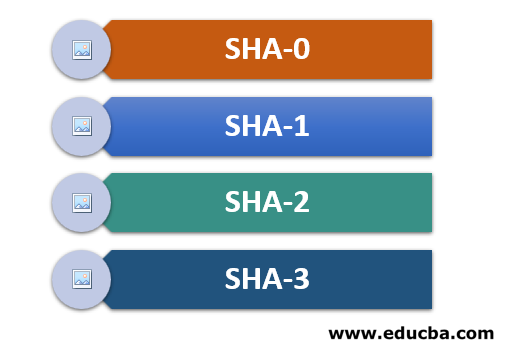Updated March 17, 2023

Introduction to SHA Algorithm
SHA algorithm is Secure Hash algorithm developed by the National Institute of Standards and Technology along with NSA, previously released as a Federal Information Processing Standard, later in 1995, it was named as SHA algorithm, design to modify the MD4, in other words, we can say that the SHA algorithm is the modified version of MD4. SHA is designed to obtain the original message, given its message digest, and find the message producing the same message.
What is SHA Algorithm?
In the field of cryptography and crypt analytics, the SHA-1 algorithm is a crypt-formatted hash function that is used to take a smaller input and produces a string that is 160 bits, also known as 20-byte hash value long. The hash value therefore generated, is known as a message digest which is typically rendered and produced as a hexadecimal number which is specifically 40 digits long.
Characteristics
- The cryptographic hash functions are utilized and used to keep and store the secured form of data by providing three different kinds of characteristics such as pre-image resistance, which is also known as the first level of image resistance, the second level of pre-image resistance and collision resistance.
- The cornerstone lies in the fact that the pre-image crypt resistance technique makes it hard and more time consuming for the hacker or the attacker to find the original intended message by providing the respective hash value.
- The security, therefore, is provided by the nature of a one way that has a function that is mostly the key component of the SHA algorithm. The pre-image resistance is important to clear off brute force attacks from a set of huge and powerful machines.
- Similarly, the second resistance technique is applied where the attacker has to go through a hard time decoding the next error message even when the first level of the message has been decrypted. The last and most difficult to crack is the collision resistance, making it extremely hard for the attacker to find two completely different messages which hash to the same hash value.
- Therefore, the ratio to the number of inputs and the outputs should be similar in fashion to comply with the pigeonhole principle. The collision resistance implies that finding two different sets of inputs that hash to the same hash is extremely difficult and therefore marks its safety.
Types of SHA Algorithm
The Different Types of SHA algorithm include the ones:
1. SHA-0
It is a retronym that is applied to the basic version of the year-old 160 bit or 20-byte long hash function, which was published back in 1993 with the name of the SHA algorithm. It was withdrawn very shortly after it was published due to a major flaw, and therefore SHA-1 came into the picture.
2. SHA-1
It is a 160 bit or a 20-byte long hash-based function-based encryption mechanism that is used to resemble the year-old MD5 algorithm. The particular algorithm was designed and developed by the NSA, i.e. the National Security Agency and was supposed to be part of the critical component- Digital Signature Algorithm (DSA). The weaknesses related to the cryptographic techniques were found in SHA-1; the encryption standard was later on discarded and was not much put to use.
3. SHA-2
This forms a family of 2 identical hash functions, which consist of differently sized block sizes which are known to be SHA-512 and SHA-256, which differ mainly in the word size. The former consists of the word value range of 32 words, whereas the latter consists of the 64-bit word value. The truncated versions of these values include SHA-224, SHA-384 and SHA-512 and SHA-224 or SHA-256.
4. SHA-3
This is the encryption technique being used mainly today, which makes use of the hash function named Keccak. The length supported is the same as that of SHA-2. Still, the majority of the difference lies in the fact that this one is structurally different as it is based on a wide range of random function generation, which typically supports all random permutations and thereby allowing inputting or absorbing, as it is called, any amount of data presented and outputting or squeezing the presented data. While doing all this, this acts as a pseudorandom function for all the inputs provided, which therefore leads to greater flexibility.
Uses of SHA Algorithm
These SHA algorithms are widely used in security protocols and applications, including the ones such as TLS, PGP, SSL, IPsec, and S/MiME. These also find their place in all the majority of cryptanalytic techniques and coding standards which is mainly aimed to see the functioning and working of majorly all governmental as well as private organizations and institutions. Major giants today such as Google, Microsoft, or Mozilla have started to recommend the use of SHA-3 and stop the usage of the SHA-1 algorithm.
Conclusion
The SHA or secured hash algorithm aims to provide an additional security level to the increasing and massive data you have to deal with. Hackers and attackers will keep finding a vulnerability in all the newer forms of hashing techniques being used. We just have to ensure that we are prompt enough to be more secure than letting our data fall prey to it. I hope you liked our article. Stay tuned for more articles like these.
Recommended Articles
This is a guide to SHA Algorithm. Here we discuss the characteristics, types, and uses of the SHA Algorithm in detail. You may also look at the following articles to learn more –


